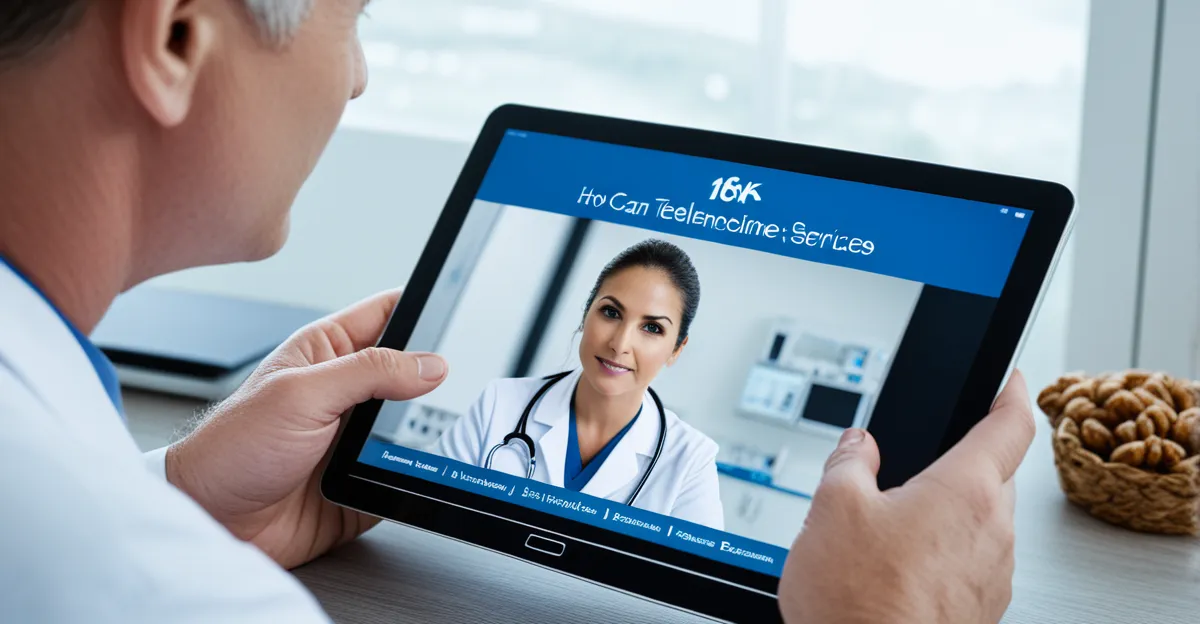Current Effectiveness of Telemedicine in the UK
In recent years, telemedicine has become a pivotal component of the UK healthcare system, transforming how remote patient care is delivered. This shift has facilitated access to health services, particularly for patients in rural or underserved areas, and has significantly reduced the burden on traditional healthcare facilities.
Overview of Existing Telemedicine Services
In the UK, telemedicine services range from virtual GP consultations to specialist referrals, using advanced communication technologies to connect patients and practitioners. These platforms often include video consultations, digital prescription services, and even remote diagnostic tools, allowing healthcare professionals to provide timely and convenient care without the need for in-person visits.
Also to see : How Are UK Healthcare Policies Evolving in Response to Technological Advancements?
Evaluation of Patient Satisfaction and Outcomes
Patient satisfaction with telemedicine effectiveness is generally high due to the convenience and time savings it offers. Patients appreciate the ability to manage their health from the comfort of their homes, with many reporting improved outcomes thanks to continuous monitoring and timely interventions. However, the effectiveness also depends on the quality of internet connectivity and user familiarity with digital tools.
Analysis of Usage Statistics and Trends
Recent trends indicate a noticeable increase in the adoption of telemedicine, spurred initially by the COVID-19 pandemic and sustained by the growing acceptance among both patients and healthcare providers. Usage statistics reveal a significant jump in remote consultations, with data showing an increase in patient engagement and a wider acceptance of digital health solutions across various demographics. This trend underscores a transformative change in the UK healthcare system, highlighting the crucial role of telemedicine in bridging gaps in healthcare delivery.
Also to see : Will Implementing Universal Healthcare Improve the UK’s Health System?
Identifying Patient Needs for Remote Care
In the realm of remote healthcare, understanding patient needs is crucial to ensuring accessibility and improving delivery. Patients who engage with telemedicine often face unique challenges that healthcare providers must address. Common challenges include limited access to reliable internet, a lack of digital literacy, and limitations in patient monitoring tools for chronic conditions. Addressing these challenges requires a holistic approach to tailor healthcare solutions for diverse populations.
Importance of Tailored Healthcare Solutions
Tailored healthcare solutions are essential in meeting the varied needs of remote patients. Such solutions involve designing services that cater to specific demographics, considering factors like age, socioeconomic status, and geographic location. For instance, older adults might require user-friendly interfaces and clear instructions for navigating telehealth platforms, while patients in rural areas may need alternative connectivity solutions. These tailored approaches are necessary to bridge the accessibility gap in remote healthcare services.
Feedback Mechanisms for Patient Experiences
Implementing robust feedback mechanisms is vital for continuous improvement of telemedicine services. Gathering patient feedback through surveys, focus groups, or direct consultations helps healthcare providers understand patient experiences and uncover areas for enhancement. This feedback can guide the development of more effective telemedicine strategies, ensuring that services are responsive to the changing needs of patients. As a result, healthcare systems can improve patient satisfaction and outcomes by incorporating patient suggestions into service design and delivery.
Technological Advancements Facilitating Telemedicine
The landscape of telemedicine innovation is rapidly evolving due to technological advancements, significantly impacting the UK healthcare system. These developments are enhancing the capabilities and reach of digital tools to improve remote patient care.
Emerging Technologies in Telemedicine
Cutting-edge technologies are driving the expansion of telemedicine services. Health technology innovations like advanced video conferencing platforms, electronic health records systems, and secure communication channels enhance the quality and accessibility of remote consultations. These technologies facilitate seamless interactions between healthcare providers and patients, ensuring efficient delivery of medical care.
Role of Artificial Intelligence in Patient Care
Artificial Intelligence (AI) plays a critical role in modern telemedicine by offering advanced tools for diagnosis and treatment recommendations. AI algorithms analyze patient data to provide timely insights, improving decision-making and personalizing patient care. Moreover, AI’s predictive analytics capabilities enable early detection of potential health issues, which leads to more proactive treatment approaches.
Integration of Wearable Devices and Remote Monitoring
The integration of wearable devices into telemedicine systems has transformed patient monitoring. These devices, such as fitness trackers and smartwatches, continuously collect health data like heart rate and activity levels. This real-time data enables healthcare providers to monitor patient conditions remotely, offering insights into long-term health trends and facilitating timely interventions. However, despite these benefits, challenges such as data security and user privacy must be carefully managed to maintain patient trust.
Policy Changes to Enhance Telemedicine Access
Implementing strategic health policy changes is vital for bolstering the reach of telemedicine within the UK’s healthcare system. Current policies lay the groundwork for telemedicine implementation, yet further enhancements can create a more robust framework for accessibility.
Review of Current Policies
The existing telehealth regulations provide a foundational structure supporting remote patient care. These regulations oversee the protection of patient privacy, data security, and adherence to medical standards. However, the rapid advancement in health technology requires updating these guidelines to keep pace with emerging tools and methodologies.
Recommendations for Regulatory Improvements
Regulatory adjustments should focus on increasing service delivery efficiency and facilitating innovation. Streamlining compliance processes and reducing bureaucratic hurdles would allow for more seamless integration of novel digital tools and telemedicine innovations. Ensuring regulatory flexibility can accommodate future advancements, encouraging the adoption of cutting-edge telehealth solutions.
Potential Funding Sources
Government funding plays a crucial role in sustaining and expanding telemedicine services. Allocating dedicated budgets for infrastructure development, technology upgrades, and training can enhance service delivery. Exploring public-private partnerships could further leverage resources, pooling expertise from diverse sectors to foster sustainable telemedicine growth across the UK.
Barriers to Accessing Telemedicine Services
While telemedicine has transformed healthcare delivery in the UK, several access barriers still challenge its potential. Addressing these issues is essential for ensuring equitable healthcare for all.
Socioeconomic Factors Impacting Access
Socioeconomic disparities significantly impact access to telemedicine services. Lower-income groups, often residing in areas with limited digital infrastructure, face hurdles in employing digital tools effectively. In these settings, affordability of necessary devices and data plans becomes a pressing concern. Moreover, financial constraints can limit access to technologies vital for effective telemedicine, further widening the healthcare gap.
Geographic Barriers for Remote Populations
Rural healthcare poses geographic barriers due to limited connectivity and scarce healthcare facilities. People in remote regions might experience difficulties in maintaining stable internet connections, crucial for remote patient care. This issue hinders the consistency and quality of telehealth services, necessitating focused efforts to expand digital infrastructure and connectivity solutions to these underserved areas.
Technological Literacy and Connectivity Issues
Technological illiteracy remains a fundamental challenge in telemedicine effectiveness. Many patients lack the skills to navigate health platforms, limiting their healthcare engagement. This issue, compounded by patchy internet service, especially in rural settings, reduces the efficiency and efficacy of telemedicine. Overcoming these obstacles requires educational initiatives to improve digital literacy, alongside investments to boost internet accessibility across diverse demographics.
Successful Case Studies in Telemedicine Improvement
In the pursuit of advancing telemedicine effectiveness within the UK healthcare system, numerous case studies provide insights into successful implementations and best practices. These examples underscore how strategic approaches and targeted efforts can enhance remote patient care.
Examples of Successful Telemedicine Programs in the UK
One such example is the NHS’s use of video consultation services during the COVID-19 pandemic, which significantly improved patient access to healthcare while minimizing physical contact. This program expanded rapidly, bolstered by investments in digital tools such as secure video conferencing platforms and user-friendly interfaces, which facilitated smoother interactions between patients and healthcare providers.
Key Strategies for Engaging and Retaining Remote Patients
Several strategies have been pivotal in engaging and retaining patients through telemedicine. These include personalized care plans that incorporate patient feedback and emphasize user-oriented design in telemedicine platforms. By focusing on intuitive digital tools and ensuring robust telemedicine effectiveness, healthcare systems have been able to retain patient participation and satisfaction.
Lessons Learned from Failed Telemedicine Initiatives
While successful case studies provide valuable insights, it’s essential to learn from less effective initiatives. Common pitfalls include neglecting to address technological literacy in diverse demographics and underestimating the necessity for comprehensive health technology infrastructure. Understanding these challenges can guide future endeavors in creating resilient telemedicine systems that cater to a wider audience. Implementing these lessons helps mitigate risks and lay the groundwork for more reliable and inclusive healthcare services.
Collaborative Efforts for Telemedicine Enhancement
As the UK healthcare system embraces increasingly sophisticated telemedicine solutions, collaborative efforts have become crucial to advancing these technologies and improving remote patient care.
Role of Healthcare Providers in Innovating Telemedicine Services
Healthcare providers play a fundamental role in driving telemedicine innovation. They are often on the frontline, identifying patient needs and use cases that can benefit from digital tools. By actively participating in the development and testing of new technologies, they ensure that solutions are practical, relevant, and patient-centric. Providers’ feedback is essential, as it shapes the evolution of health technology and ensures that advancements align with clinical requirements and enhance the quality of care.
Engagement Between Policymakers, Tech Companies, and Healthcare Systems
Effective health policy plays a pivotal role in shaping the landscape of telemedicine. Policymakers need to understand technological capacities in this sector and work closely with tech companies to establish frameworks that encourage innovation while maintaining stringent safety and privacy standards. This partnership fosters an environment where healthcare systems can integrate cutting-edge digital tools smoothly. Collaborative dialogues between these stakeholders prove invaluable in aligning technological advancements with public health goals, ensuring that telemedicine remains a holistic, patient-focused solution.
Impact of Public-Private Partnerships on Telemedicine Delivery
Public-private partnerships (PPPs) have shown great potential in broadening the accessibility of telemedicine. These alliances harness resources and expertise from both sectors, accelerating the deployment of telehealth solutions. Through PPPs, the financial burdens of technology integration can be alleviated, enabling more comprehensive development of telemedicine infrastructure. Additionally, such partnerships can tap into varied innovation pools, spurring the introduction of nuanced telemedicine innovations that cater to diverse populations and their unique healthcare demands.











